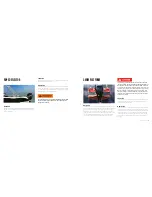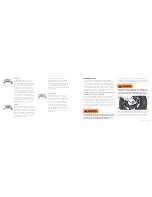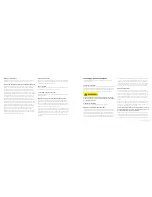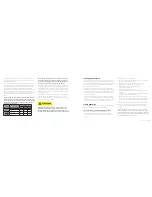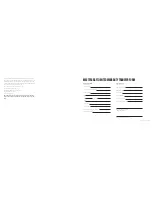
2017 OWNERS MANUAL /
424
Braking System
Disc brakes offer several advantages over drum brakes. Disc
brakes have improved resistance to fade on downhill grades. They
are self-adjusting, so as the pads wear, braking efficiency is not
reduced. This type of brake recovers quickly after being submerged.
They also require less maintenance, are easier to flush out, and are
less susceptible to water-induced corrosion. The trailer’s brakes are
designed to energize automatically when the tow vehicle’s brakes
are applied. These are known as “surge brakes.”
NOTE: Some jurisdictions do not allow surge brakes. Always check
within the locality in which you will be towing.
When the vehicle slows down or stops, the forward momentum
(surge) of the trailer against the hitch ball develops hydraulic pres-
sure in a master cylinder inside the trailer brake actuator. Hydraulic
lines are used to transfer pressure to the brakes and engage them.
In most states, trailers with a Gross Vehicle Weight Rating (GVWR)
of 1,500 pounds or more are required by law to have brakes on all
wheels. (Auto manufacturers generally recommend brakes even
with lighter trailers.)
Trailer brakes must be maintained in good working condition at all
times. Inspect the brake system on a regular basis and verify prop-
er fluid level in the actuator. The loss of adequate braking could
result in serious injury or death and/or property damage.
The trailer is equipped with a hydraulic brake actuator. Trailer brakes
will automatically apply whenever the tow vehicle’s brakes are applied.
Stopping (deceleration) force is developed in direct proportion to the
stopping force generated by the tow vehicle.
The breakaway system actuators will apply the trailer brakes if the
trailer becomes completely detached from the tow vehicle while under
power. Failure to properly connect the breakaway system prior to
towing may result in serious injury or death and/or property damage.
The breakaway cable is a line of defense at separation. Before the
breakaway cable is pulled, the coupler must become detached from
the hitch ball and the safety chains must fail. At this time the break-
away cable is pulled and applies a braking force to the trailer.
Cupping
Cups or scalloped dips appearing around the
edge of the tread on one side or the other al-
most always indicate worn (sometimes bent)
suspension parts. Adjustment of wheel align-
ment alone will seldom cure the problem. Any
worn component that connects the wheel to
the trailer (wheel bearings, springs, bushings,
etc.) can cause this condition.
Worn components should be adjusted
or replaced with new ones. The worn tire
should be balanced and possibly moved to a
different location on the trailer. Occasionally,
wheels that are out of balance will wear like
this, but wheel imbalance usually shows up
as bald spots between the outside edges and
center of the tread.
Second-Rib Wear
Second-rib wear is normally found only in
radial tires, and appears where the steel
belts end in relation to the tread. Normally, it
can be kept to a minimum by paying careful
attention to tire pressure and frequently
rotating the tires. Some tire manufactures
consider a slight amount of wear at the
second rib of a radial tire to be normal, but
excessive amounts of wear indicate that the
tires are too wide for the wheels. Be careful
when having oversized tires installed on
narrow wheels.
One side wear
In instances where an inner or outer rib
wears faster than the rest of the tire, there
may be a need for a realignment of the tires.
This occurs when there is excessive camber
in
the axle, causing the wheel to lean too
much to the inside or outside and putting
too much load on one side of the tire. The
trailer may simply need the wheels aligned,
but misalignment could be due to sagging
springs, overloaded trailer or an unbalanced
load on multi-axle trailers. Because load
has a great effect on alignment, be sure the
trailer is loaded to balance the weight on the
axle or axles. Trailers should be towed with
the trailer level, this is particularly important
with independent suspension trailers using
torsion axles.
Summary of Contents for NXT20 2017
Page 3: ...2017 OWNERS MANUAL SAFETY KNOWLEDGE ...
Page 27: ...2017 OWNERS MANUAL 48 2017MODEL FEATURESANDSPECS ...
Page 40: ...2017 OWNERS MANUAL 74 DASHESAND VIDEOSCREENS ...
Page 42: ...2017 OWNERS MANUAL 78 XANDXTSERIESINSTRUMENTPANEL 4 3 VIDEOSCREEN XSTARINSTRUMENTPANEL ...
Page 43: ...2017 OWNERS MANUAL 80 PROSTARINSTRUMENTPANEL NXTSERIESINSTRUMENTPANEL ...
Page 58: ...2017 OWNERS MANUAL 110 XANDXTSERIES VIDEOSCREEN OPERATIONSHV450 ...
Page 67: ...2017 OWNERS MANUAL 128 XSTAR VIDEOSCREEN OPERATIONS XSTARINSTRUMENTPANEL ...
Page 80: ...2017 OWNERS MANUAL 154 PROSTAR VIDEOSCREEN OPERATIONS ...
Page 97: ...2017 OWNERS MANUAL 188 NXT OPERATIONS ...
Page 101: ...2017 OWNERS MANUAL 196 NXT20 22 VIDEOSCREEN OPERATIONS ...
Page 107: ...2017 OWNERS MANUAL 208 BOAT OPERATIONS ...
Page 158: ...2017 OWNERS MANUAL 310 PREPARATION ...
Page 172: ...2017 OWNERS MANUAL 338 CAREAND MAINTENANCE ...
Page 204: ...2017 OWNERS MANUAL 402 TRAILERS ...


